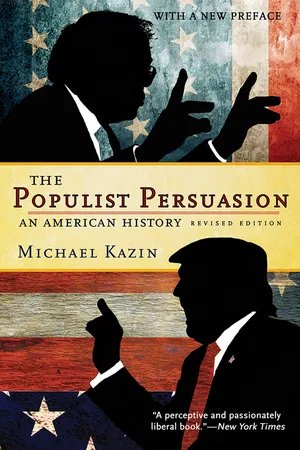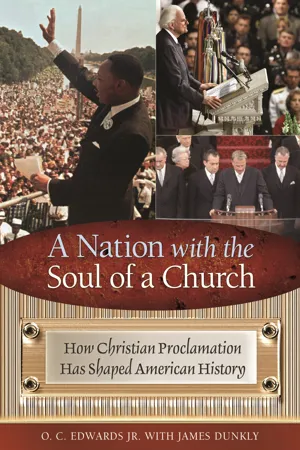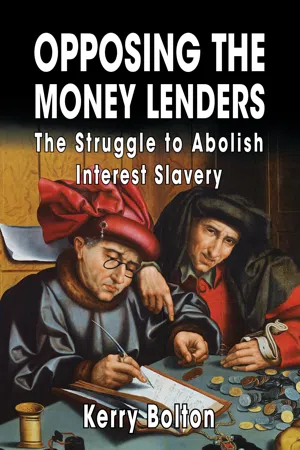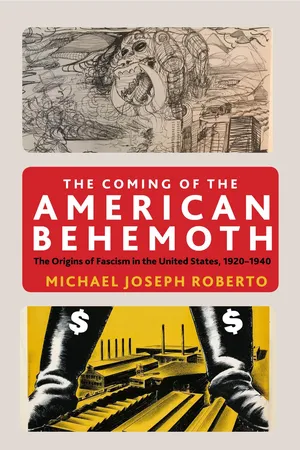History
Father Coughlin
Father Charles Coughlin was a controversial Catholic priest and radio personality in the 1930s known for his populist and anti-Semitic views. He used his platform to criticize the government and promote social justice, but also spread conspiracy theories and fascist sympathies. Coughlin's influence waned as his extreme rhetoric alienated many listeners and political allies.
Written by Perlego with AI-assistance
Related key terms
4 Key excerpts on "Father Coughlin"
- eBook - ePub
The Populist Persuasion
An American History
- Michael Kazin(Author)
- 2017(Publication Date)
- Cornell University Press(Publisher)
What explains the tremendous popularity across denominational lines of a parish priest who never ran for elective office or sought to scale the hierarchy of his church? No doubt, Coughlin attracted millions of casual listeners who took him no more seriously than they did other radio orators. But an undeterminable number looked to him for political guidance because he stirred a potent blend of convictions: the fervent advocacy of Catholic social doctrine, hostility toward high finance and a shadowy state, and the desire for an uncompromising leader to point the way out of the Depression. Coughlin was a new kind of evangelical populist. Like the moribund prohibitionists, he spoke more to his followers’ loss of psychological security and the nation’s apparent fall from social harmony than to the oppression of American workers.During the first half of the 1930s, the radio priest delivered a syncretism of messages in a lilting voice that both delighted and inflamed. He enthusiastically translated papal encyclicals about labor and poverty into the American vernacular. He unraveled the complexities of banking transactions and legislation concerning the economy. He ridiculed pompous men of wealth like J. P. Morgan and allegedly myopic government officials like General Hugh Johnson, the director of the National Recovery Administration (NRA). He invoked both Christian morality and the secular republicanism of the Founding Fathers. He advised Americans to follow wise, altruistic leaders while urging them to be suspicious of anyone who currently held national and political power. Soothingly, Coughlin showed that Catholicism and American democracy could be complementary creeds, thus helping break a long “counter-subversive” tradition (dating back to the colonial era) that argued to the contrary.11Early in 1933, Coughlin compared the three years that veterans of World War I had waited for Congress to pass a bonus bill with “the three hours of agony endured by Christ on the cross.” Then, he vowed:We are determined once and for all to attack and overpower the enemy of financial slavery; to oppose and to defeat those who still support the ancient heresy of the concentration of wealth in the hands of a few…. In this venture can we rely on you, on every sane American to take his place in the ranks of justice? The real fight is just beginning. - eBook - ePub
A Nation with the Soul of a Church
How Christian Proclamation Has Shaped American History
- O. C. Edwards Jr., James Dunkly(Authors)
- 2013(Publication Date)
- Praeger(Publisher)
That move prompted an enormous number of letters to the Vatican asking that Coughlin be permitted to continue broadcasting. With the permission of the Apostolic Delegate, he resumed on January 9, 1938. When Coughlin began broadcasting again, he revealed how greatly he had deteriorated. Apparently in losing the election he had lost confidence in the democratic process. It is commonly said that he became a fascist, but Charles Tull argues that “[t]he priest was a frustrated, disgruntled demagogue lashing out at the world around him, but he was no fascist,” 35 a judgment for which there is much to be said. It is true that at times he expressed admiration for the governments of Mussolini and Hitler, but some of that admiration can be put down to ethnic prejudice. Many of his followers were Catholics of Italian, German, or Irish lineage. Like many Irish, Coughlin despised the English for their treatment of his people. Yet his ranting and raving became progressively more embarrassing after the beginning of World War II in Europe in 1939, and especially after the entry of the United States in late 1941. The most distressing aspect of his new subject matter was a virulent anti-Semitism. While some have assumed that he had held such attitudes all along and only later felt free to express them, a more convincing explanation has been offered by Mary Christine Athans. 36 At the time Coughlin was feeling so vulnerable, he encountered the writings of an Irish priest, Father Denis Fahey, C.S.Sp., who gave him a thought-system onto which he could project all his anxieties. Building on a Thomist framework that had never led anyone else into such ideas, Fahey taught that anyone not in the Holy Catholic Church, the mystical body of Christ, was a part of its opposing group, the “Body of Organized Naturalism,” headed by its Natural Messiah, the Antichrist, who was probably the Jewish Messiah - eBook - ePub
Opposing the Money Lenders
The Struggle to Abolish Interest Slavery
- Kerry Bolton(Author)
- 2019(Publication Date)
- Black House Publishing Ltd(Publisher)
Father Charles CoughlinFather Charles Coughlin
F or centuries, as we have seen in the “Introduction,” the Catholic Church had condemned usury as a sin, and money-lenders charging interest on loans were regarded as among the lowest of people frequently subjected to riots and even death. The Church also developed a social doctrine that culminated in the Encyclical of Pope Leo XIII, Rerum Novarum (1891) in regard to the relations of Labour and Capital, as an alternative to what the Church saw as the twin atheistic materialism of socialism and capitalism. In 1931 Pius XI issued his Encyclical letter Quadragesimo Anno. Both capitalism and socialism concentrated property rather than allowing its ownership widely; capitalism by placing ownership in the hands of a few private owners; socialism by concentrating property in the hands of the state.This social doctrine inspired significant movements, including in England the Distributist movement headed by the well-known Catholic authors Hilaire Belloc and G. K. Chesterton, and many Catholics supported Social Credit. In the USA the world-wide reaction against rapacious capitalism and its rulers, the international bankers, took its most significant form in Father Charles Coughlin’s National Union for Social Justice.In Canada in 1939 another remarkable Catholic movement dedicated to Church social doctrine, with the focus on Social Credit, was the Pilgrims of St. Michael, established by Louis Even and Gilberte Côté-Mercier. Also known as the White Berets the movement still exists and has maintained its crusading zeal, publishing its journal Michael, - eBook - ePub
The Coming of the American Behemoth
The Origins of Fascism in the United States, 1920 -1940
- Michael Joseph Roberto(Author)
- 2018(Publication Date)
- Monthly Review Press(Publisher)
As reactionaries who have been categorized as fascist, quasi-fascists, or fascist forerunners, Long and Coughlin shaped a potent and infectious politics based on the meshing of nativism, anti-communism, and attacks on Roosevelt and the New Deal. Many recent writers tend to distinguish nativism from fascism as a political feature distinct to American society. Others have argued that the changing political character of nativism caused by economic dislocation in the early and mid-1920s, and the crisis decade of the thirties, generated political extremism that could turn fascist if and when merged with the interests of the most reactionary elements of the ruling capitalist class.Coughlin’s radio ministry began in 1926, only three years after he took his final vows in the diocese of Detroit. His superior, Bishop Michael Gallagher, had told him to build a church in the suburb of Royal Oak. There were few Catholic families in the parish, but Gallagher saw great potential in new parishioners from the auto industry. It was also a suburb heavily in the grips of the Ku Klux Klan. This was of little concern to Gallagher, who instructed his ambitious and determined young prelate to “build a church at the crossroads of faith and religious persecution,” and “make it a missionary oasis in the desert of religious bigotry.” Coughlin did just that. Even after the Klan burned a cross on the front lawn of his new church, the Shrine of the Little Flower, Coughlin’s resolve to establish a Catholic presence in the community only strengthened. But this required financing beyond diocesan support. Recognizing the power of his oratory as a preacher, Coughlin approached the manager of a local radio station to propose a radio ministry. With Bishop Gallagher’s blessing, and with the financial backing of the station owner, Coughlin went on the air for the first time on October 17, 1926, dressed in vestments and standing at the altar of his church.42By generally avoiding controversial issues and instead focusing on Catholic teachings, Coughlin became increasingly popular in Detroit. While neutralizing the Klan threat, his radio ministry expanded to the rest of Michigan. Meanwhile, people flocked to his small church, prompting him to build a bigger church on the very spot where the Klan burned its cross. Rising from a large octagonal church and central altar, Coughlin imagined a “tower that would climb to the sky to the Virgin Mary’s bosom.” Though he claimed the sole purpose of building the church was to give people work, the construction company he hired used non-union labor at wages below the union level. As he preached to the suffering whose money was scarce, Coughlin spent over $800,000 to build the new church.43
Index pages curate the most relevant extracts from our library of academic textbooks. They’ve been created using an in-house natural language model (NLM), each adding context and meaning to key research topics.



